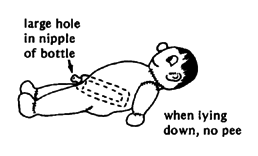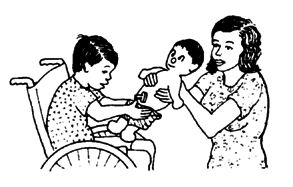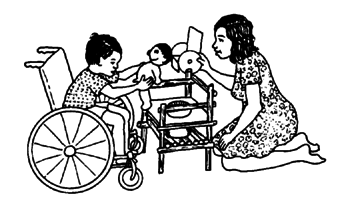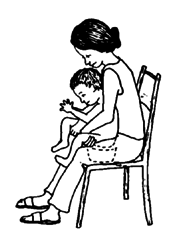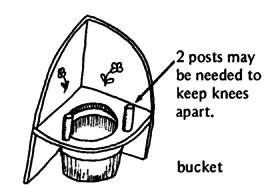CHAPTER 38
Toilet Training
By 'toilet training' we mean helping a child learn to stay clean and dry. A child is toilet trained when:

| He knows when he needs to shit or pee (make stool or urinate) and has learned to 'hold on' so he does not go in his clothing or on the floor (bowel and bladder control). | |
| He tells people when he needs to do his toilet, or (if he is physically able) ... | |
| he takes himself to a special place (pot, toilet, latrine, or at least outside the house), removes necessary clothing, 'goes', cleans himself in the customary way, puts his clothing back on, and does whatever may be necessary to get rid of the waste. |
'Toilet training' is important for the development of a child's independence and dignity. Yet it is very often neglected in disabled and retarded children. Often we see children 5, 10, even 15 years old who are still in diapers (nappies) and who are still completely dependent on their mothers for being changed and cleaned. This situation is hard on both child and family. With a little instruction and encouragement, we have found that many of these children have become 'toilet trained' in a few days or weeks. Many could have learned years earlier.
The age when normal children become toilet trained varies greatly from child to child. It also varies from place to place, according to local customs, what clothes children wear (if any), and how much the family helps. With training, many children can stay dry and clean by age 2 or 2½. With little or no training, most normal children learn to stay clean and dry by age 4.
Children who are developmentally slow, or physically disabled, are often late in learning to stay clean and dry. This may be partly due to their disabilities. But often it is because the parents have not provided the opportunity, training, and help that the child needs. For example, one mildly retarded deaf 10-year-old boy in Mexico still depended on his mother to change his diapers. His mother had never seriously tried to teach him and thought he could not learn. Yet with a little help from a village rehabilitation worker, he became completely toilet trained in 3 days!
Handicapped children should be helped to become as independent as possible in their toileting. With help, most retarded or disabled children can become completely toilet trained by ages 3 to 5.
Of course, children with severe physical disabilities may always need help with clothing or getting to the pot. But they can learn to tell you when they have to go, and do their best to 'hold on' until they are on the pot.
Children who lack bladder and bowel control because of spina bifida or spinal cord injury have special problems. But even these children can often learn some control and become relatively or completely independent. The special problems and training of these children are discussed in Chapter 25.
WAYS TO MAKE TOILET TRAINING EASIER
1. Start when the child is ready
Just as training should not be delayed, it also should not be started too early. If a child's body is not yet able to control her bladder and bowel, trying to train her can lead to failure and frustration-both for the child and her parents. Normally a child is 'ready' by age 2 or 2½. But in some children, training may need to be delayed to age 3 or 4, or sometimes later.
Most children learn to keep clean a long time before they learn to stay dry. However, because a child pees much more often than she shits, if training aims at 'staying dry', 'staying clean' usually follows.
There are 3 simple tests to cheek if your child is 'ready' for toilet training. These are: bladder control, readiness to cooperate, and physical readiness.*
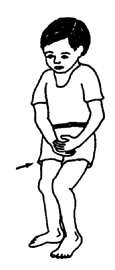
- Bladder control
- Does your child pee a lot at one time and not dribble every few minutes?
- Does he often stay dry for hours?
- Does he seem to know when he is about to pee? (The look on his face, holding himself between the legs, etc.)
- If the child does these 3 things (or at least the first 2) he probably has enough bladder control and awareness of peeing to make training possible.
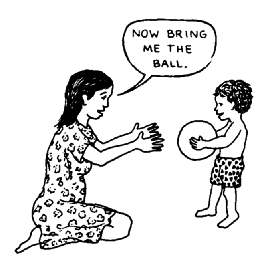
- Readiness to cooperate.
- To test whether the child has enough understanding and cooperation, ask her to do a few simple things: lie down, sit up, point to parts of her body, put a toy in a box, hand you an object, and imitate an action like hand clapping. If she does all these things willingly, she is probably mentally ready for toilet training.
- Physical readiness.
- Can the child pick up small objects easily? Can she walk or move herself fairly well? Can she squat, or sit on a stool, and keep her balance? If so, she is probably physically able to do her toilet by herself. If not, she can probably still be trained but may need physical assistance.
Most children more than 2 years old can pass these 3 tests. If not, it is.usually better to wait before trying toilet training, or to help the child become more ready.
![]()
*These tests and many of these suggestions on toilet training are adapted from Toilet Training in Less Than a Day. Azrin and Foxx. Pocket Books, N.Y. 1974.
SPECIAL PROBLEMS
![]()
If the child still does not have enough bladder control or awareness, it is best to wait until she is older. For example, some children with cerebral palsy are slow in developing bladder control.
If the child does not hear or understand simple language, or is mentally retarded, more of the training needs to be done by showing and less with words. Special gestures or 'signs' need to be worked out for 'wet', 'dry', 'dirty', 'clean', and 'pot' or 'latrine'. Instead of teaching by using a doll, it is more helpful to have another child demonstrate toilet use.
If the child is stubborn, refuses to cooperate when asked to do simple things, or often cries and screams whenever he does not get what he wants, toilet training will be more difficult. Stubbornness and refusal to do what they are told are common in many handicapped children- mainly because they are often overprotected or spoiled. Before trying to toilet train such children, it is wise to work first on improving their attitude and behavior. This is discussed in Chapter 40.
If a child's physical disability makes it difficult for her to get to the toilet place, to lower her pants, to squat or sit, or to clean her butt, various aids or ways must be looked for to help her become as independent as possible. These will be discussed on the next pages.
2. Put the child on the pot at the times when she is most likely to use it

Before beginning toilet training, for several days notice at what time of the day the child shits and pees. Usually there will be certain times when she usually does so-for example, soon after the first meal of the day.
Begin to put her on the pot or latrine at these times, encouraging her to make 'poo' or 'pee' (or whatever she calls it).
Leave her on the pot until she 'goes'-or for no more than 10 minutes.
If the child 'goes', clap your hands, kiss her, show her what she has done, and let her know how pleased you are.
If she does not 'go', just ignore it. Do not scold or make her feel bad, or she may begin to fear or dislike the pot, and refuse to use it.
3. Reward and praise success
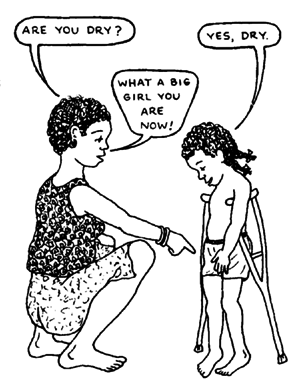
In toilet training-as in any form of education- it works better to reward success than to punish failure. When the child shits or pees where she should, give her praise, hugs, kisses and other signs of approval. However, make sure that the child knows you are pleased with her, not because she shits and pees, but because she is staying dry or clean. When training, check the child often to see if she is 'dry' or 'clean'. When she is praise her. Also, teach her to check herself.
When the child has 'an accident' and wets or dirties herself do not punish or scold her. It is better to quietly clean up the mess or change her. At most, say something friendly (but not approving) like, "Too bad! - Better luck next time!"
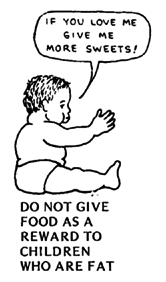
CAUTION: As a general rule, do not offer a child candy, sweets or other food as a reward for doing something right. This can lead the child to associate food with love or approval-and therefore to make constant demands for sweets. Avoiding food rewards is especially important for children whose disability makes them less active, so that they easily get fat. Extra weight makes moving around harder for both child and parents. So ... DO NOT LET DISABLED CHILDREN GET OVERWEIGHT. For children who are thin and active, it may make sense to sometimes give foods as rewards. But be sure to include healthful foods like nuts and fruits-not just sweets. |
4. Guide the child's movements with your hands-not your tongue

When the child has difficulty carrying out a physical task-for example, lowering his pants-do not do it for him (if it is something he can learn to do for himself). And do not tell him his mistakes or how to correct them. Instead, gently guide his hands with yours so that he learns how to do it himself.
5. Use models, examples, and demonstrations
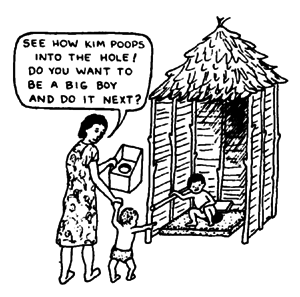
Setting an example is one of the best ways of teaching-especially if the example is set by persons the child loves, admires, and tries to copy. Even before children are old enough to be toilet trained, help prepare them by letting them watch their brothers and sisters use the pot or latrine. Tell them that when they are big enough they will be able to do it that way too.
Using a doll that wets is another good way to introduce toilet training. Dolls that 'wet' can be bought, or you can make one out of,
| a gourd
|
| or a baby bottle inside a homemade
rag doll.
|
Show the child how the doll pees in the pot. Or better, ask your child to help you toilet train the doll. Be sure to include each step that will be needed for the child to become as self-reliant as possible. For example:
| First have the child show the doll how to get to the
latrine or pot - and then help the doll lower his pants.
|
| Next have the child teach the doll how to get onto the
pot, and sit there until he pees. Try to make the situation as
nearly like that of the child as you can - using the same pot
in the same place that he will use it.
Turn it into a game, but keep the focus always on toilet training. |
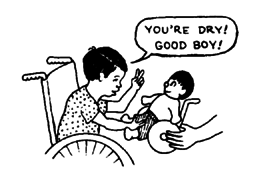
After the doll has finished peeing, have the child pull up the doll's pants. Ask him to feel the doll's pants and check whether they are dry. If so, have him praise the doll. |
To repeatedly see real persons (not just dolls) enjoy and be rewarded for using the pot or toilet is especially important for a child who is retarded or who has language difficulty.
6. Adapt toileting to the special needs of the child
Many handicapped children can be helped to become independent in their toileting if special aids or adaptations are made. Different children will require different adaptations. However, the following are often helpful:
| If the child has trouble pulling down pants or panties- use loose fitting clothing with elastic or 'Velcro' waist band. |
Correct position of hands, for lowering pants
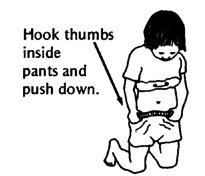
for raising pants
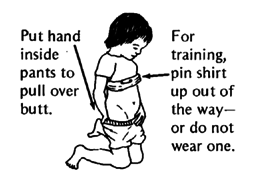

| Use short 'training pants' made of towel- like material that will soak up urine. |
![]()
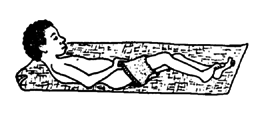
| For a child with cerebral palsy or spina bifida, it may be easier lying down-you might provide a clean mat. |

| If people by custom squat to shit, and the child has trouble, a simple hand support can help. |

| Latrines can also be adapted |
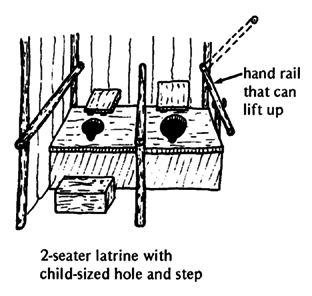

Make the outhouse (latrine) and its door big enough so that a wheelchair can fit inside. Position the door so that the wheelchair can enter right beside the latrine without having to turn around.
Be sure the path to the latrine is level and easy to get to from the house.
· A simple pot or 'pottie' is one of the best aids for toilet training of young children. It can be adapted in various ways for disabled children.

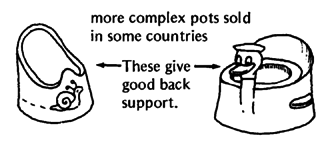
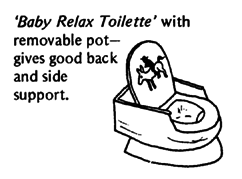
![]()
| For the child severely disabled with cerebral palsy, the
pot can be placed between mother's knees. This provides good
back support. Mother holds his shoulders forward, his hips
bent and his knees separated.
|
| Later it may be possible to put the child on a corner seat
like this-which also holds arms and shoulders forward and
helps keep hips bent.
|
| A cardboard box can also make a good sitting frame.
|
Use your imagination and whatever materials you can get to make it easier for your child to do it by herself.



For severely handicapped children, 'toilet seats' can be built into specially designed chairs.
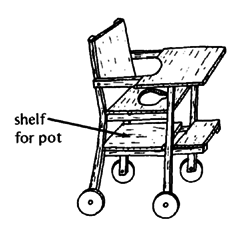

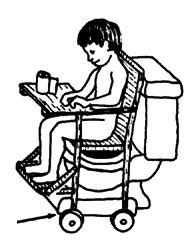
Or leave the space under the seat open, so that the whole chair can be rolled over a toilet.
For the child who cannot sit up, you might make a wedge-shaped toilet box like this
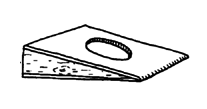

An old plastic bucket can be cut at the same angle as the bedpan so that it fits snugly under the hole.
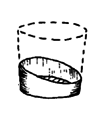
or as a 'floor pan' for the child who can roll or scoot but cannot sit or lift himself without help. This way the child can learn to take care of his own toilet.
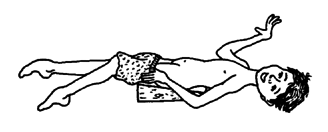
![]()
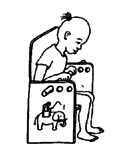
For the child who has spasticity or poor balance, you can make a seat like this. The bar can be put in after the child has been seated.
The seat can be made to fit over a bucket, over a floor-hole latrine, or over a standard toilet.
Tire potty seat-soft, safe, washable*
Tire can be used alone,
or over a 'hole-in-the-floor' toilet,

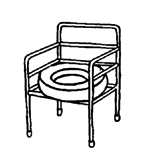
or on a wood or metal frame over a toilet seat.
Try to pick size of tires to match the size of the child. For small children, scooter or very small car tires may work well.
Cane or rattan toilet seat with climb up bars*
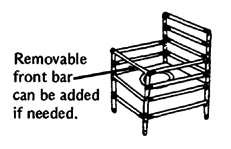
Enclosed wood or plywood toilet*

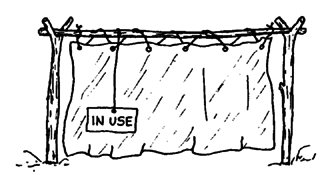
REMEMBER: As the disabled child grows, she will feel the same need of privacy as any child would for toileting and other personal acts. Help the child to obtain the privacy she needs.
*Ideas from India-UPKARAN manual. See Page 642.


